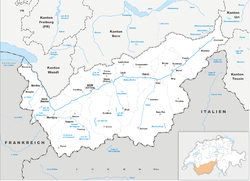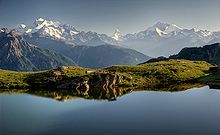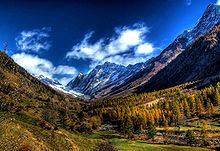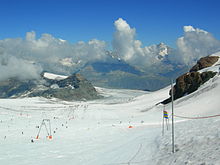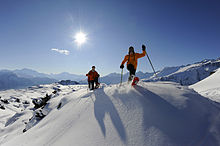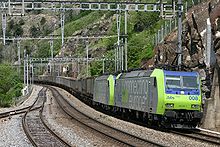- Valais
-
Canton du Valais
Kanton Wallis— Canton of Switzerland — 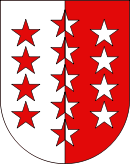
Coat of armsCoordinates: 46°4′N 7°36′E / 46.067°N 7.6°ECoordinates: 46°4′N 7°36′E / 46.067°N 7.6°E Capital Sion Subdivisions 143 municipalities, 13 districts Government – Executive Conseil d'Etat, Staatsrat (5) – Legislative Grand Council (130) Area[1] – Total 5,224.25 km2 (2,017.1 sq mi) Population (12/2009)[2] – Total 307,392 – Density 58.8/km2 (152.4/sq mi) Highest point 4,634 m (15,203 ft) - Monte Rosa Lowest point 372 m (1,220 ft) - Lake Geneva Joined 1815 Abbreviation VS Languages French, German Website VS.ch The Valais (French pronunciation: [valɛ]; German: Wallis, German pronunciation: [ˈvalɪs] (
 listen)) is one of the 26 cantons of Switzerland in the southwestern part of the country, around the valley of the Rhône from its headwaters to Lake Geneva, separating the Pennine Alps from the Bernese Alps. The canton is one of the drier parts of Switzerland in its central Rhône valley. Paradoxically, it is also one of most well-watered parts, having large amounts of snow and rain up on the highest peaks found in Switzerland. The canton of Valais is probably best known for the Matterhorn and ski resorts such as Zermatt and Verbier.
listen)) is one of the 26 cantons of Switzerland in the southwestern part of the country, around the valley of the Rhône from its headwaters to Lake Geneva, separating the Pennine Alps from the Bernese Alps. The canton is one of the drier parts of Switzerland in its central Rhône valley. Paradoxically, it is also one of most well-watered parts, having large amounts of snow and rain up on the highest peaks found in Switzerland. The canton of Valais is probably best known for the Matterhorn and ski resorts such as Zermatt and Verbier.Contents
History
See also: Bishops of SionThe Romans called the upper Rhône valley Vallis Poenina. The Vallis Poenina was won by the Romans after a great fight at Octodurus (Martigny) in 57 B.C., and was so thoroughly Romanized that both the Celtic original inhabitants and the Germanic Burgundian invaders of the 5th century, became romance language-speaking peoples. According to a tradition which can be traced back to the middle of the 8th century, the Theban legion was martyred at Agaunum (now Saint Maurice) about 285 or 302. From 888 onwards the lands were part of the kingdom of Jurane Burgundy.[3]
Valais formed part of the kingdom of Transjurane Burgundy, which fell to the Holy Roman Empire in 1032. It became part of the duchy of Burgundia Minor, which was held from the emperors by the house of Zahringen (which went extinct in 1218). In 999, King Rudolph III of Burgundy gave all temporal rights and privileges to the Bishop of Sion, who was later styled praefect and count of the Valais and is still a prince of the Holy Roman Empire. The count-bishops then struggled to defend their area against the Zahringen and then the dukes of Savoy, so that the medieval history of the Valais is inextricably linked with that of the diocese of Sion. The Dukes of Savoy, however, succeeded in winning most of the land west of Sion, while in the upper part of the valley (Upper Valais) there were many feudal lords, such as the lords of Raron, those of La Tour-Chatillon, and the counts of Visp.[3]
About the middle of the 13th century, the large communities (Zenden or tithings) began to develop independence and grow in power. The name Zenden or tithings probably came from a very ancient division of the bishop's manors for administrative and judicial purposes. In the same century the upper part of the valley was colonized by Germans from Hasli in the Canton of Bern. The locals became German speaking, though many Romance local names still remain. In 1354 the liberties of several of the seven Zenden (Sion, Sierre, Leuk, Raron, Visp, Brig and Conches) were confirmed by the Emperor Charles IV.[3]
By the late 14th century, the counts of Savoy acquired the bishopric of Sion. The Zenden resisted his attempts to gather both spiritual and secular power in the valley. In 1375-76, Zenden forces crushed the army of the house of La Tour-Chatillon, and in 1388 utterly defeated the forces of the bishop, the count and his nobles at Visp. The German-speaking Zenden spread further into the valley. Starting in 1384 the Morge stream (a little below Sion) was recognized as the boundary between Savoyard, French speaking Lower Valais and German speaking episcopal Upper Valais.
During the Raron affair rebellion in 1414 to 1420, some cantons of the Swiss Confederation took sides in the Valais. Lucerne, Uri and Unterwalden supported the Upper Valais rebels, while Bern supported the noble Raron family. The uprising was successful in driving out the Rarons, and almost brought the Confederation to civil war.[4]
With the election of Walther von Supersax of Conches as bishop in 1457, the German speaking part of the valley finally won the supremacy. At the outbreak of the Burgundian War in 1475 the bishop of Sion and the Zenden made a treaty with Bern. In November of the same year they seized all Lower or Savoyard Valais up to Martigny. In March 1476, after the victory of Grandson, they advanced and captured St Maurice, Evian, Thonon and Monthey. They had to give up the last three districts in 1477, but won them again in 1536. In the treaty of Thonon in 1569, Monthey, Val d'llliez and Bouveret were permanently annexed to the Valais. These conquered districts in the Lower Valais were always ruled as subject lands by the bishop and Zenden of the Upper Valais. On March 12, 1529, Valais became an associate member (Zugewandter Ort) of the Swiss Confederation.[3]
The Valais resisted the Protestant Reformation, remaining faithful to the Roman Catholic Church. In 1628 the Valais became a republic, the République des Sept Dizains/Republik der Sieben Zehenden, under the guidance of the prince-bishop of Sion and the bailli. The bishop remained in power until 1798 when Napoleon's troops invaded the Valais and declared a Revolutionary République du Valais (March 16) which was swiftly incorporated (May 1) into the Helvetic Republic until 1802 when it became the separate Rhodanic Republic. In 1810 the Rhodanic Republic was annexed by Napoleonic France as the département of Simplon. Independence was restored in 1813, and on August 4, 1815 the Valais finally entered the Swiss confederation as a canton. In 1845, the Valais joined the Catholic separate league (Sonderbund) which led to what is called the Sonderbund War. 99,000 Swiss Federal troops under General Henri Dufour were faced by 79,000 Separatists, but in the end the Valais chose not to fight.
Geography
The canton of Valais lies in the southwest of Switzerland. To its south lies Italy, to the southwest France. To the north the canton is bounded by the Swiss cantons of Vaud and Bern; the cantons of Uri and Ticino lie to its east.
The wide, glacial Rhône valley dominates the area. There are many side valleys which branch off the main valley. These vary from narrow and remote to reasonably populous and popular. At the head of the Mattertal valley lies Zermatt, a pretty tourist village dominated by views of the Matterhorn (4,478 m). Fifty of the mountains exceed 4,000 m with the highest, Monte Rosa, reaching 4,638 metres (15,217 ft), and there are numerous glaciers including several of the largest in the Alps.
The Rhône drains almost the entire canton and flows in the main valley from east to west down to Martigny, then in a right angle north to its mouth in Lake Geneva. After the small town of Saint-Maurice, the northern banks of the river belong to the canton of Vaud. However two areas are located on the south side of the Alps and are drained by the Po river: the valley south of the Simplon Pass and the small area south of the Great St. Bernard Pass. The main valley is bounded by the Bernese Alps in the north and the Pennine Alps in the south. Other ranges situated partially in Valais are the Chablais Alps, the Mont Blanc Massif, the Urner Alps and the Lepontine Alps. Only about half of the total area is considered productive.
Political subdivisions
Districts
Valais is divided into 13 districts:
Lower Valais:
- Conthey with capital Conthey
- Entremont with capital Sembrancher
- Hérens with capital Evolène
- Martigny with capital Martigny
- Monthey with capital Monthey
- Saint-Maurice with capital Saint-Maurice
- Sierre with capital Sierre
- Sion with capital Sion
Upper Valais:
- Brig with capital Brig-Glis
- Goms with capital Münster-Geschinen
- Leuk with capital Leuk
- Östlich Raron with capital Mörel-Filet
- Visp with capital Visp
- Westlich Raron with capital Raron
Municipalities
Main article: Municipalities of the canton of ValaisThere are 143 municipalities in the canton (As of 2009[update]).[5]
Demographics
Valais is predominantly French- and Arpitan-speaking. The eastern part of the canton (Upper Valais), however, speaks Walliser German. The French-speaking population makes up slightly more than two-thirds of the total population.
The canton is thinly populated. Its population (as of 31 December 2009) is 307,392.[2] As of 2007[update], the population included 57,061 foreigners, or about 19.1% of the total population.[6] The largest towns are the capital Sion (Sitten), Monthey, Sierre, Martigny and Brig. There is no major city located in the canton. As of 2000[update] 81% of the population is Roman Catholic, while only 6% are Protestant.[7]
Economy
Wine and fruit cognacs, e.g. "Williamine" production and tourism are some of the main industries of the canton. The Matterhorn near Zermatt is one of the biggest tourist attractions in the Swiss mountains, as is its sister valley immediately east Saas Fee. Other parts of the mountains of the canton further west are popular as well, such as the more French-speaking resorts near Verbier and the Evolene and Arolla region. The resorts on the north side of the main Rhône river valley are popular, looking out southwards towards the Peninne Alps and still part of the southern slope of the Bernese Alps, such as the family-oriented resort of Crans-Montana. The resorts in the Goms region are slightly less known, yet also receive attention during the summer hiking season and the winter ski season.
Apart from tourism, agriculture is still important, particularly cattle breeding in the mountains and dairy farming in the plains. The wine industry of the canton is the largest in Switzerland. There are also a large number orchards in the area, and saffron is also gathered here.
Europe's tallest gravity dam is located at Grande Dixence in the canton. Hydroelectric power plants from the canton produce about a quarter of Swiss electricity.
The west part and the most industrial region of the canton is called Chablais. The area is very important for the economy. The lands from the Valais part of Lake Geneva to the town of St-Maurice are located in the Chablais. There are a lot of factories, the most important are the subsidiaries of Novartis and Syngenta, in Monthey. In the town of Collombey-Muraz, there is an oil refinery.
Near Visp there is a large aluminium processing plant. Other metal products and chemicals are produced around Visp and Sierre.
Tourism
The Valais has a long touristic tradition. Hoteliers were at the base of the important development of Valais Tourism. Many of them, such as César Ritz, spent time and money to satisfy a clientele from around the world. They have therefore largely contributed to the reputation which has benefited to many generations of Valais inhabitants and will
The Valais counts more than 120 winter and summer destinations, including:
- Vallée de Conches ("Goms" in German): Fiesch-Eggishorn, Bellwald, Binn, Ernen, Obergoms, Oberwald
- Aletsch (UNESCO World Heritage): Bettmeralp, Fiescheralp, Riederalp
- Brig and surrounding area: Blatten, Belalp, Mund (municipality) Mund, Termen, Birgisch
- Visp and surrounding area: Visperterminen, Bürchen, Eischoll, Stalden, Törbel, Unterbäch
- Zermatt with CervinMount Cervin and the largest summer ski area of Switzerland, on the southern slopes of Breithorn reachable from the cable car station of the small Matterhorn (Klein Matterhorn).
- Saas Valley Saas-Fee,Saas-Almagell,Saas-Grund with Fee glacier, the second largest ski area of was in Switzerland.
- Leuk-les-Bains
- Sierre, Salquenen and Anniviers,Chandolin, St. Luc,Grimentz,Vercorin,Zinal
- Crans-Montana
- Sion and surrounding Anzère, Val Hérens, Arolla,Euseigne,Evolène,Hérémence, Mase, Saint-Martin
- 4 Vallées ski area: Nendaz,Verbier,Veysonnaz,Thyon-Les Collons, Mayens-de-Riddes/La Tzoumaz
- Chablais Valais and Portes du Soleil,Champéry,Champoussin,Morgins,The Crosets,Torgon,Val -d 'Illiez,The Bouveret, Saint-Maurice,Monthey,Evionnaz, St. Gingolph
- St. Bernard Region: Les Marécottes, Bruson, La Fouly, Champex, Vichères-Liddes.
Some resorts Valais enjoy an international renown. Most stations are located more than 1500 meters (a.s.l) and 9 ski regions lie 3000 meters (a.s.l), which guarantees snow during the winter season.
Wellness, beauty and fitness are an old tradition in Valais. The Romans already knew the beneficial properties of the "healing waters Valais". The area is famous for its spas found at Saillon in Leuk-les-Bains in Ovronnaz in Val-d'Illiez, in Breiten and Brigerbad.
In Valais, the following resorts have been awarded the quality label which gives them the distinction of "Family welcome places":
(Bellwald Bettmeralp Crans-Montana Ernen Fiesch Grächen Grimentz Leukerbad Bains Nendaz Saas-Almagell Saas-Fee Saas-Grund Zinal)
These, and many other stations offers include: climbing parks, barbecues fireplaces, theme trails, wildlife parks, adventure parks, etc. Animation programs ranging from cooking classes to painting lessons also composed the touristic offer. The various accommodation offer various services such as child care, equipment rental, extra beds, chairs for children and special menus.
The Valais has 9 golf courses in total, five 18-hole courses: Crans Montana Leuk-les-Bains, Sierra, Sion Verbier 9-hole and 4 Crans Montana Obergesteln Riederalp and Zermatt.
Related to the constant evolution of the tourism industry, the Valais has seen the development of a large range of activities, such as theme park as Happyland New, The Adventure Labyrinth, the Swiss Steam Park and Aquaparc.
Transport
A small airport is located at Sion, but the main routes of transport are rail and road. Both networks are extensive and benefit from tourism. There are three major rail tunnels at the Simplon (Simplon Tunnel), Lötschberg (Lötschberg Tunnel) and Furka (Furkatunnel) and a road tunnel at the Great St Bernard. Many of the road passes are well known, such as the Grimsel Pass. The longest land tunnel in the world, the Lötschberg Base Tunnel, is in operation since late 2007, connecting by rail the town of Frutigen in canton Bern, with the town of Visp in canton Valais/Wallis. This is to better allay car traffic in the highly scenic Kandertal, and also to provide faster transport through the Bernese Alps from the populous Mittelland in the north to the southern canton of Valais. Cars may be loaded onto the trains as freight. The old train line still carries traffic particularly road traffic as freight, and has highly scenic sections in both cantons on either side of the old tunnel through the dividing ridgeline, yet is somewhat slower than the new route which has a much longer tunnel section.
Because of the tourism there are many mountain railways and cable cars in the mountains. The scenic rail route across the Furka Pass originates in the canton of Valais.
See also
References
- ^ Arealstatistik Standard - Kantonsdaten nach 4 Hauptbereichen
- ^ a b Swiss Federal Statistical Office, MS Excel document – Bilanz der ständigen Wohnbevölkerung nach Kantonen, Bezirken und Gemeinden (German) accessed 25 August 2010
- ^ a b c d
 One or more of the preceding sentences incorporates text from a publication now in the public domain: Chisholm, Hugh, ed (1911). "Valais". Encyclopædia Britannica (11th ed.). Cambridge University Press.
One or more of the preceding sentences incorporates text from a publication now in the public domain: Chisholm, Hugh, ed (1911). "Valais". Encyclopædia Britannica (11th ed.). Cambridge University Press. - ^ Raron Affair in German, French and Italian in the online Historical Dictionary of Switzerland.
- ^ "Liste officielle des communes de la Suisse - 01.01.2008". Office fédéral de la statistique. http://www.bfs.admin.ch/bfs/portal/fr/index/infothek/nomenklaturen/blank/blank/gem_liste/03.Document.90142.xls. Retrieved 15 décembre 2008.
- ^ Federal Department of Statistics (2008). "Ständige Wohnbevölkerung nach Staatsangehörigkeit, Geschlecht und Kantonen" (Microsoft Excel). http://www.bfs.admin.ch/bfs/portal/de/index/themen/01/02/blank/key/raeumliche_verteilung/kantone__gemeinden.html. Retrieved November 5, 2008.
- ^ Federal Department of Statistics (2004). "Wohnbevölkerung nach Religion" (Interactive Map). http://www.bfs.admin.ch/bfs/portal/de/index/themen/01/05/blank/key/religionen.html. Retrieved 2009-01-15.
External links
 Media related to Valais at Wikimedia Commons
Media related to Valais at Wikimedia Commons- Cantonal government (French) (German)
- Official information from Valais Tourism
Three Cantons · Eight Cantons · Thirteen Cantons · coats of arms historical cantons: Unterwalden ·
Unterwalden ·  Basel ·
Basel ·  Appenzell · Baden · Bellinzona · Fricktal · Léman · Linth · Lugano · Oberland · Raetia · Säntis · Waldstätten
Appenzell · Baden · Bellinzona · Fricktal · Léman · Linth · Lugano · Oberland · Raetia · Säntis · WaldstättenClient states of the French Revolutionary and Napoleonic Wars (1792–1815) French client
republics- Helvetia
- Lemania
- Rauracia
- Rhodania
- Swiss Confederation
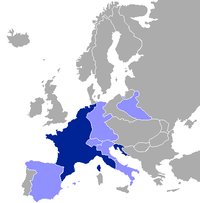
Europe at the height of Napoleon's Empire Other
Napoleonic
creations- Etruria
- Lucca and Piombino
- Kingdom of Italy
- Naples
Categories:- Valais
- Cantons of Switzerland
- Cantons of the Helvetic Republic
- Wine regions of Switzerland
- Arpitany
Wikimedia Foundation. 2010.


